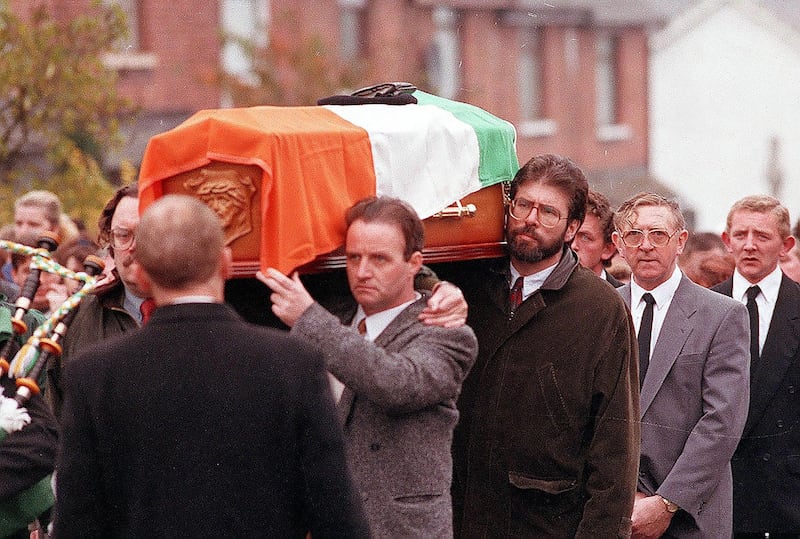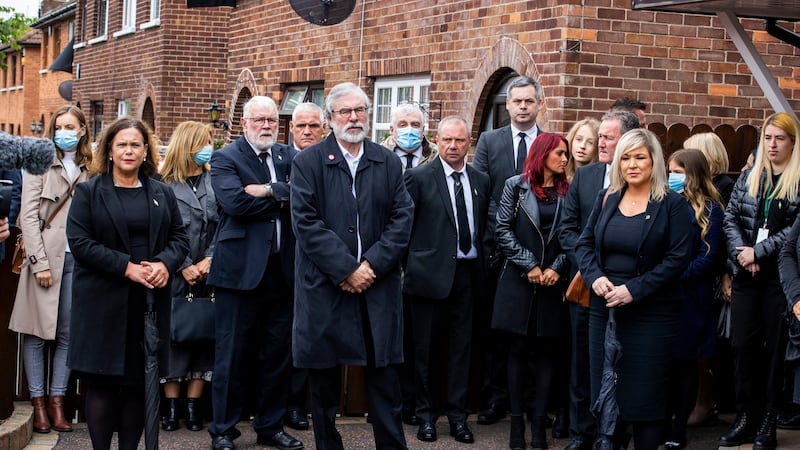It’s macabre, but nonetheless true, to say that on occasions IRA funerals have served Sinn Féin well in the republican transition from the Armalite to the ballot box.
You could even argue that IRA funerals – most notably those of the hunger strikers – helped set in motion the political success of Sinn Féin, directing it to a place where it can see itself in tantalising sight of Government Buildings.
But IRA funerals have caused difficulties too for Sinn Féin – and on occasion have resulted in horrifying events.
This is an important weekend for Troubles republicans, whether of Provisional, Official, or dissident stamp, as they gather at various cemeteries and locations throughout the island to remember their members killed during the conflict and, of course, to pay obeisance to the executed leaders of Easter 1916.
READ MORE
But burying, or cremating, the IRA dead has always been controversial or incendiary. Such was the case when Mairead Farrell, Daniel McCann and Sean Savage, who were killed by the SAS in Gibraltar, were brought home to be buried in the republican plot in Milltown Cemetery in West Belfast in 1988.

It resulted in a dreadful week in which the catalogue of grim events included loyalist Michael Stone killing three people in the cemetery. Three days later, at the funeral of Caoimhín Mac Brádaigh two young British army corporals, Derek Wood and David Howes, were beaten, stripped and murdered on waste ground.
That whole week of funeral after funeral was the stuff of nightmares.
The funeral of Thomas Begley, who was killed with his own bomb that took the lives of nine innocent people on the Shankill Road in October 1993 caused further outrage after Gerry Adams helped shoulder Begley’s coffin.
It was something Adams probably had to do in order not to fracture the republican base just as the peace process was developing some traction, but it was a bad image.
In 2018, Sinn Féin defended its decision to attend a ceremony marking the 25th anniversary of Begley’s death, saying there was a responsibility to attend “respectful commemorations for fallen comrades”.

The thousands who turned up for the funeral of former IRA man Bobby Storey in 2021 during Covid sparked a different kind of controversy over whether social distancing restrictions had been broken.
But from the point of view of republicans, it was essential to mark the death of one of the leaders of The Great Escape, the IRA breakout of 38 prisoners from the Maze Prison in 1983, and the man who masterminded the £26.5 million Northern Bank robbery and the break-in at the supposedly impenetrable Castlereagh RUC special branch offices in east Belfast.
It was the 1981 hunger strikes, in which ten republicans died, that proved the bedrock for the future political success of Sinn Féin on both sides of the Border.
An estimated 100,000 people attended the funeral of the first to die, Bobby Sands, with huge turnouts at subsequent funerals demonstrating to the likes of Adams, Martin McGuinness and Danny Morrison that there also was a political way forward.
Those events marked the start of the rise and rise of Sinn Féin.

And now the last thing Mary Lou McDonald and Michelle O’Neill want is for anything unexpected to happen to upset that trajectory.
On cue came the recent deaths of Rose Dugdale and Pearse McAuley which offered an awkward juxtaposition for Sinn Féin, as Dugdale was lauded and, even in death, McAuley ostracised.
The Irish reluctance or suspicion of speaking ill of the dead did not seem to apply to McAuley, who was imprisoned for the manslaughter of Det Gda Jerry McCabe in Limerick in 1996 and later jailed for the 2014 stabbing of his estranged wife, Pauline Tully, now a Sinn Féin TD. McAuley was cast from the fold which will have annoyed some old guard republicans.
It was different when it came to commemorating Rose Dugdale, but even so, there were subtleties in how the party dealt with her funeral. There is a degree of romance attached to her life considering her privileged background and her part in one of the great world art heists and the failed helicopter bomb attack on the RUC barracks in Strabane.
So, it was reasonably safe to celebrate her life with the veteran republican contingent – including Gerry Adams, Martina Anderson, Marion Coyle, Dugdale’s partner Jim Monaghan and Dessie Ellis – turning out in strength to mark her passing. But the new leaders Mary Lou McDonald and Michelle O’Neill stayed away, as if some distance was being created between the paramilitary past and the political present.

And that probably was wise because, as Sinn Féin strives to achieve its goal of government in the Republic, its political opponents will seek to focus on the past, and all those funerals whether of IRA people or IRA victims.
The first salvo in that battle was fired by Senator Michael McDowell in his Irish Times column this week when he addressed how Dugdale was involved in bomb-making which may have accounted for scores of deaths in Northern Ireland and in Colombia.
Sinn Féin’s general response to such charges is that the past should be left to the past, that the “war is over” and that the party and its leaders want to deal in the present and look to the future, to resolve “real issues” such as housing and the cost of living.
That strategy has worked so far. But it won’t stop Fine Gael and Fianna Fáil resurrecting the republican past as the general election approaches, and it could be a dominant feature of what is likely to be a brutal campaign.
The memories elicited by the funerals of Rose Dugdale and Pearse McAuley proved the truth of the words of American writer William Faulkner* when he said, “The past is never dead. It’s not even past”.
*This article was amended on April 1st, 2024
- Listen to our Inside Politics Podcast for the latest analysis and chat
- Sign up for push alerts and have the best news, analysis and comment delivered directly to your phone
- Find The Irish Times on WhatsApp and stay up to date












